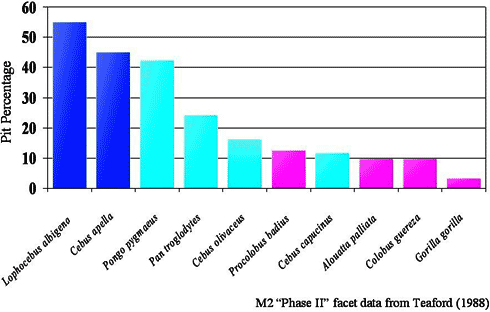Dental Microwear
Reconstructing Diets
Dental microwear has been examined on the molar teeth and incisors of a wide variety of primates and other animals. Patterns of dental microwear on mammalian molar teeth reflect the material properties of food items eaten.
For example, heavily pitted molar surfaces typically suggest a diet consisting of harder, more brittle food items (such as hard seeds, nuts or bone). In contrast, a heavily scratched shearing facet on a molar tooth usually indicates that that tooth was used to shear tough food items (such as leaves or meat). Intermediate patterns indicate mixed diets, or diets with intermediate food properties (such as soft fruits). Patterns of dental microwear on the incisors indicate the importance of anterior tooth use in food processing

This graph shows ratios of pits to scratches on Phase II molar wear surfaces of numerous living primate species using data from Teaford (1988). Taxa to the far left, such as Lophocebus (Cercopithecus) albigena and Cebus apella eat lots of hard nuts and seeds and have many more pits than scratches on their molar teeth. In contrast, primates that eat many tough items, such as Gorilla gorilla, Colobus guereza and Alouatta palliata have many more scratches than pits. Soft-fruit eaters, such as Pan troglodytes and Cebus olivaceus have intermediate ratios of pits to scratches.
